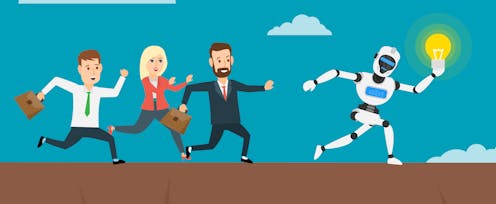Boeing crashes and Uber collision show passenger safety relies on corporate promises, not regulators
Government regulators and industry experts often overlook the complexities and risks of human-technology interactions and increasingly rely on companies' voluntary oversight and self-assessments.

Advanced technologies deliver benefits every day. But, sometimes interactions with technology can go awry and lead to disaster.
On March 10, the pilots aboard Ethiopian Airlines Flight 302 were unable to correct a failure in one of the Boeing 737 Max 8’s automated systems, resulting in a crash and the deaths of all passengers and crew. A year earlier, almost to the day, another automated vehicle – not an airplane but an Uber self-driving car – struck and killed Elaine Herzberg in Tempe, Arizona.
As experts in how humans and technologies interact, we know that it is impossible to completely eliminate risk in complex technological systems. These tragedies are the result of regulators and industry experts overlooking the complexities and risks of interactions between technologies and humans and increasingly relying on companies’ voluntary self-assessment, rather than objective, independent tests. Tragically, that appears to have happened with Boeing’s aircraft and the Uber car.
Risky business
The crash of Ethiopian Airlines Flight 302, as well as that of Lion Air Flight 610 in 2018, happened despite oversight from one of the most technologically capable regulators in the world. Air travel is remarkably safe in light of the potential risks.
Before the 737 Max 8 took to the air, it had to pass a series of Federal Aviation Administration inspections. Over the course of that process, Boeing convinced the FAA that the automated system was safer than it actually was, and that pilots would need very little training on the new plane.
The FAA cleared the 737 Max 8 and its flight control system to fly – and retained that clearance not only after the Lion Air crash, but also for three days after the Ethiopian Airlines tragedy.
From airplanes to automobiles
As airplane automation is increasing, the same is true for cars. Various companies are testing autonomous vehicles on roads all around the country – and with far less oversight than the aviation industry. Local and federal rules are limited, often in the name of promoting innovation. Federal safety guidelines for autonomous vehicles require them to pass only the same performance tests as any other car, like minimum fuel economy standards, seat belt configurations and how well they’ll protect occupants in a rollover crash.
There’s no reliability testing of their sensors, much less their algorithms. Some states do require companies to report “disengagements” – when the so-called “safety driver” resumes control over the automated system. But mostly the self-driving car companies are allowed to do what they want, so long as there is a person behind the wheel.
In the months before the March 2018 collision, Uber was under pressure to catch up with GM Cruise and Waymo. Uber’s cars had a sensitive object-recognition system, which at times would be deceived by a shadow on the road and brake to avoid an obstacle that wasn’t actually there. That resulted in a rough, stop-and-start ride. To smooth things out, Uber’s engineers disabled the car’s emergency braking system. The company appears to have assumed the single safety driver would always be able to stop the car in time if there was really a danger of hitting something.
That’s not what happened as Elaine Herzberg crossed the road. The Uber self-driving car that hit and killed her did see her with its sensors and cameras, but was unable to stop on its own. The safety driver appears to have been distracted by her phone – in violation of Uber’s policies, though it’s unclear how the company briefed its safety drivers about the change to the automated system.
Policing themselves
Regulators are relying on safety self-assessment practices, whereby private companies vouch for their own products’ compliance with federal standards. The best assurances they – and members of the public – have for the safety and reliability of these vehicles are the guarantees of the companies who intend to sell them.
What reports companies do provide can be slim on hard evidence, touting the number of real and simulated miles driven, without details of how the cars are performing under various conditions. And car companies are constantly releasing new models and upgrading their software, forcing human drivers to learn about the new features.
This is all the more unnerving because there are far more cars on the roads than there are planes in the air – 270 million cars registered in the U.S. alone, compared with 25,000 commercial aircraft worldwide. In addition, self-driving cars have to handle not just weather conditions but also close-range interactions with other cars, pedestrians, cyclists and e-scooters. Safety drivers don’t get nearly the amount of training that pilots do, either.
Arizona, where we’re based, is a popular place for public testing of autonomous vehicles, in part because of looser oversight than in other states. In the Phoenix area, however, there is growing public concern about safety. Some citizens are harassing autonomous vehicles in efforts to discourage them from driving through their neighborhoods. As one Arizona resident told The New York Times, the autonomous vehicle industry “said they need real-world examples, but I don’t want to be their real-world mistake.”
Connecting with the public, innovating responsibly
In the absence of federal safety standards for autonomous vehicles, states and local governments are left to protect the public – often without the expertise and resources to do so effectively. In our view, this doesn’t mean banning the technology, but rather insisting on corporate transparency and true regulatory oversight.
Engaging the public about what’s happening and who is – and isn’t – protecting their safety can help officials at all levels of government understand what their citizens expect, and push them to ensure that technological innovation is done responsibly.
Universities can play an important role in supporting responsible innovation on these issues. The Arizona State University Center for Smart Cities and Regions is working with the Consortium for Science, Policy and Outcomes to host public forums on self-driving cars in cities across the U.S. and Europe.
Airplane and car passengers need to trust their vehicles and understand what risks are unavoidable – as well as what can be prevented. Relying on industry to self-regulate when lives and public trust are at stake is not a viable path to ensure that rapidly emerging innovations are developed and deployed responsibly. To the riders, customers and others sharing the road and the skies, there is only one bottom line – and it doesn’t have a dollar sign attached to it.
The authors do not work for, consult, own shares in or receive funding from any company or organisation that would benefit from this article, and have disclosed no relevant affiliations beyond their academic appointment.
Read These Next
Drones, physics and rats: Studies show how the people of Rapa Nui made and moved the giant statues –
The mysteries of Easter Island, subjects of speculation for centuries, yield to scientific inquiry.
As US hunger rises, Trump administration’s ‘efficiency’ goals cause massive food waste
Despite the administration’s claim of streamlining the government to make its operations more efficient,…
A year on, the Israeli-Lebanese ceasefire looks increasingly fragile − could a return to cyclical vi
Since the start of the truce on Nov. 27, 2024, there have been thousands of Israeli violations inside…





